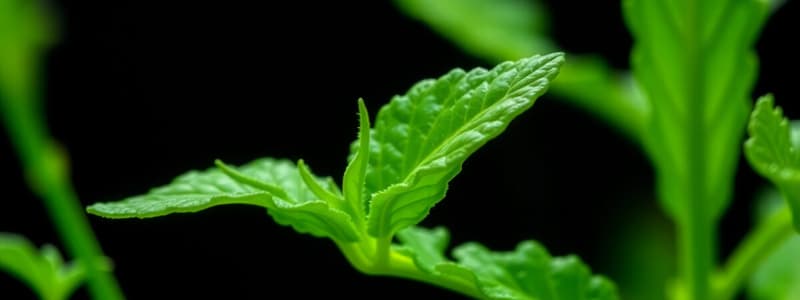Podcast
Questions and Answers
What primary role does chlorophyll play in photosynthesis?
What primary role does chlorophyll play in photosynthesis?
- It acts as a biochemical catalyst for plant growth.
- It stores nutrients for the plant.
- It helps in the absorption of carbon dioxide.
- It transforms light energy into chemical energy. (correct)
Which type of chlorophyll directly participates in the light reactions of photosynthesis?
Which type of chlorophyll directly participates in the light reactions of photosynthesis?
- Chlorophyll a (correct)
- Chlorophyll d
- Chlorophyll c
- Chlorophyll b
How does chlorophyll contribute to the process of photolysis?
How does chlorophyll contribute to the process of photolysis?
- It absorbs nutrients from the soil.
- It stores energy generated during respiration.
- It aids in the splitting of water molecules. (correct)
- It directly produces glucose from light.
Which environmental factor does NOT affect chlorophyll function?
Which environmental factor does NOT affect chlorophyll function?
What is produced as a byproduct during the photolysis of water facilitated by chlorophyll?
What is produced as a byproduct during the photolysis of water facilitated by chlorophyll?
Flashcards
What is chlorophyll?
What is chlorophyll?
A green pigment found in chloroplasts of plants, algae, and cyanobacteria. It's essential for photosynthesis.
What's chlorophyll's role in photosynthesis?
What's chlorophyll's role in photosynthesis?
Chlorophyll absorbs light energy, particularly from blue and red wavelengths, converting it into chemical energy.
What are the types of chlorophyll?
What are the types of chlorophyll?
The main pigment (chlorophyll a) directly captures light for energy conversion. The accessory pigment (chlorophyll b) expands light absorption and passes energy to chlorophyll a.
How does chlorophyll work during photosynthesis?
How does chlorophyll work during photosynthesis?
Light absorption excites electrons in chlorophyll molecules, initiating photosynthesis. These electrons then travel through a series of proteins in the thylakoid membrane called the electron transport chain.
Signup and view all the flashcards
What's the role of chlorophyll in water splitting?
What's the role of chlorophyll in water splitting?
Chlorophyll aids in the splitting of water molecules (photolysis), releasing oxygen as a byproduct and providing electrons for the electron transport chain.
Signup and view all the flashcardsStudy Notes
Photosynthesis: Chlorophyll Function
-
Definition of Chlorophyll:
- A green pigment found in the chloroplasts of plants, algae, and cyanobacteria.
- Essential for the process of photosynthesis.
-
Role in Photosynthesis:
- Absorbs light energy, primarily from the blue and red wavelengths of sunlight.
- Transforms light energy into chemical energy.
-
Types of Chlorophyll:
- Chlorophyll a:
- The primary pigment involved in photosynthesis.
- Directly participates in the light reactions.
- Chlorophyll b:
- Accessory pigment that broadens the absorption spectrum.
- Transfers energy to chlorophyll a.
- Chlorophyll a:
-
Mechanism of Action:
- Light absorption excites electrons in chlorophyll molecules.
- Excited electrons are transferred through a series of proteins in the thylakoid membrane, known as the electron transport chain.
-
Photolysis of Water:
- Chlorophyll aids in the splitting of water molecules (photolysis) during light reactions.
- Produces oxygen as a byproduct and provides electrons for the electron transport chain.
-
Importance in Energy Conversion:
- Chlorophyll facilitates the conversion of solar energy into ATP (adenosine triphosphate) and NADPH (nicotinamide adenine dinucleotide phosphate), which are essential for the Calvin cycle.
-
Impact on Plant Health and Growth:
- Adequate chlorophyll levels are crucial for effective photosynthesis and overall plant vitality.
- Chlorophyll concentration can indicate the health status of a plant.
-
Environmental Factors Affecting Chlorophyll Function:
- Light intensity and quality.
- Temperature.
- Water availability.
- Nutrient levels in the soil.
Chlorophyll Overview
- Green pigment located in chloroplasts of plants, algae, and cyanobacteria.
- Crucial for photosynthesis, enabling plants to convert sunlight into energy.
Role in Photosynthesis
- Absorbs light energy primarily from blue and red wavelengths.
- Converts absorbed light energy into chemical energy necessary for plant growth.
Types of Chlorophyll
- Chlorophyll a:
- The main pigment directly involved in converting light energy during photosynthesis.
- Chlorophyll b:
- Acts as an accessory pigment that expands the range of light absorption and transfers energy to chlorophyll a.
Mechanism of Action
- Light absorption excites electrons within chlorophyll molecules, initiating photosynthesis.
- Excited electrons travel through the electron transport chain within the thylakoid membrane.
Photolysis of Water
- Chlorophyll plays a role in the photolysis of water molecules during light-dependent reactions.
- This process generates oxygen as a byproduct and provides electrons for further energy conversion.
Importance in Energy Conversion
- Enables the transformation of solar energy into ATP and NADPH, essential for the Calvin cycle.
- ATP and NADPH are critical for the synthesis of glucose and other carbohydrates.
Impact on Plant Health and Growth
- Sufficient chlorophyll levels are vital for effective photosynthesis and plant vitality.
- Chlorophyll concentration is an indicator of plant health and overall growth success.
Environmental Factors Affecting Chlorophyll Function
- Various factors influence chlorophyll's effectiveness:
- Light intensity and quality can enhance or inhibit photosynthesis.
- Temperature extremes may affect chlorophyll production and function.
- Water availability is crucial for maintaining chlorophyll levels.
- Nutrient levels in the soil impact chlorophyll synthesis and plant health.
Studying That Suits You
Use AI to generate personalized quizzes and flashcards to suit your learning preferences.




